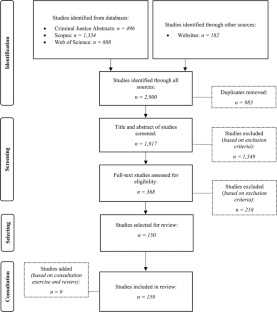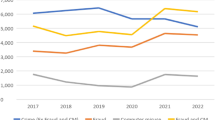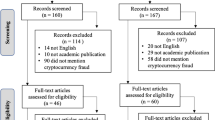Abstract
As awareness has grown internationally of the harms caused by financial fraud, there has been a concomitant increase in efforts to prevent and control it. Despite this growing awareness, the literature addressing measures against financial fraud has not yet been systematically reviewed or synthesised. On the basis of a scoping literature review, this study provides a structured overview of the literature on prevention and control measures targeting financial fraud (n = 159). We classify these measures on the basis of four functions specified by Maesschalck and Bertók (2009): “determining and defining,” “guiding,” “monitoring,” and “enforcing.” Looking at a period of just over 20 years, we see that a growing number of studies have been published on this topic, with most focusing on “monitoring” (k = 98) and the least on “enforcing” (k = 37). With 11.3% and 12.0% of the studies respectively, both criminology and Europe are less represented in the literature than expected. Most studies are cross-sectional, many are methodologically weak, and they all provide only limited information on the effectiveness or the costs of the anti-fraud measures. The literature is thus not up to the challenge of facing what has become one of the most frequent and threatening crimes worldwide. In the conclusion, we sketch an agenda for future research to help address this gap.



Similar content being viewed by others
Notes
“Prevention” and “control” measures are not mutually exclusive: the implementation of criminal laws, for example, serves both repressive and, through deterrence, preventive functions.
COSO is a private-sector initiative dedicated to improving organisational performance and governance through effective internal control, enterprise risk management, and fraud deterrence (COSO. Retrieved from http://www.coso.org/Pages/Default.Aspx on 6 December 2021).
References
Akomea-Frimpong, I., & Andoh, C. (2020). Understanding and controlling financial fraud in the drug industry. Journal of Financial Crime, 27(2), 337–354.
Alanezi, F., & Brooks, L. (2014). Combatting online fraud in Saudi-Arabia using general deterrence theory (GDT) [Paper presentation]. Twentieth Americas Conference on Information Systems, Savannah, GA.
Albanese, J. S. (2005). Fraud: The characteristic crime of the twenty-first century. Trends in Organized Crime, 8(4), 6–14.
Alleyne, B., & Elson, R. (2013). The impact of federal regulations on identifying, preventing, and eliminating corporate fraud. Journal of Legal Ethical and Regulatory Issues, 16(1), 91–106.
Alm, J. (2012). Measuring, explaining, and controlling tax evasion: Lessons from theory, experiments, and field studies. International Tax and Public Finance, 19, 54–77.
Andreadakis, S. (2019). Enhancing whistleblower protection: ‘It’s all about the culture’. [Paper presentation]. International Whistleblowing Research Network Conference, Utrecht, The Netherlands.
Arksey, H., & O’Malley, L. (2005). Scoping studies: Towards a methodological framework. The International Journal of Social Research Methodology, 8(1), 19–32.
Barra, R. A. (2010). The impact of internal controls and penalties on fraud. Journal of Information Systems, 24(1), 1–21. https://doi.org/10.2308/jis.2010.24.1.1
Bezuidenhoud, L., & Geldenhuys, D. (2019). Identifying organisational climate elements that can be used to detect and prevent management fraud. Southern African Business Review, 23, 1–28.
Biegelman, M. T., & Bartow, J. T. (2012). Executive roadmap to fraud prevention and internal control: Creating a culture of compliance. Wiley.
Black, W. (2009). Those who forget the regulatory successes of the past are condemned to failure. Economic and Political Weekly, 44(13), 80–86.
Bowe, M., & Jobome, G. (2001). Regulating securities fraud: Evidence from unauthorised trading cases. Journal of Financial Regulation and Compliance, 9(2), 151–160.
Bragg, S. (2021). Accounting tools. Retrieved at November 3, 2021, from https://www.accountingtools.com/Articles/the-Difference-between-Internal-and-External-Audits.html.
Braithwaite, J. (2016). In search of Donald Campbell: Mix and multimethods. American Society of Criminology, 15(2), 417–437.
Bunga, R., Rafael, S., Dethan, M., & Arthana, K. (2020). Whistleblowing systems and competence of internal auditor for fraud prevention. International Journal of Scientific & Technology Research, 9(2), 3171–3175.
Burke, K. (2015). Fear based motivation: Dodd-Frank’s new sentencing guidelines for insider trading lead to an extension of tippee liability. New England Journal on Criminal and Civil Confinement, 41(2), 395–420.
Bussmann, K.-D. (2007). The control paradox and the impact of business ethics: A comparison of US and German companies. Monatsschrift Für Kriminologie Und Strafrechtsreform, 90(2/3), 260–276.
Button, M., Blackbourn, D., Lewis, C., & Shepherd, D. (2015). Uncovering the hidden cost of staff fraud: An assessment of 45 cases in the UK. Journal of Financial Crime, 22(2), 170–183. 10.1108JFC-11-2013-00D70
Cascarino, R. E. (2013). Corporate fraud and internal control: A framework for prevention. Wiley.
Chêne, M. (2017). The role of external auditing in fraud and corruption. Transparency International.
COSO. (1992). Internal control - Integrated framework. Committee of sponsoring organizations of the treadway commission.
COSO. (2021). COSO. Retrieved at December 6, 2021, from https://www.coso.org/pages/default.aspx.
Cross, C., & Kelly, M. (2016). The problem of “white noise”: Examining current prevention approaches to online fraud. Journal of Financial Crime, 23(4), 806–818.
Daudt, H. M. L., van Mossel, C., & Scott, S. J. (2013). Enhancing the scoping study methodology: A large, inter-professional team’s experience with Arksey and O’Malley’s framework. BMC Medical Research Methodology, 13(1), 1–9.
Dorn, N. (2010). The governance of securities: Ponzi finance, regulatory convergence, credit crunch. The British Journal of Criminology, 50(1), 23–45.
FCA. (2014). Financial incentives for whistleblowers. Financial Conduct Authority.
Ghazali, M., Rahim, M., Ali, A., & Abidin, S. (2014). A preliminary study on fraud prevention and detection at the state and local government entities in Malaysia. Procedia-Social and Behavioral Sciences, 164, 437–444.
Goldmann, P. (2010). Financial services anti-fraud risk and control workbook. Wiley.
Gupta, P. K., & Gupta, S. (2015). Corporate frauds in India — Perceptions and emerging issues. Journal of Financial Crime, 22(1), 79–103.
Guttentag, M., Porath, C., & Fraidin, S. (2008). Brandeis’ policeman: Results from a laboratory experiment on how to prevent corporate fraud. Journal of Empirical Legal Studies, 5(2), 239–273.
Hakami, T., & Rahmat, M. (2019). Fraud prevention strategies: The perception of Saudi Arabian banks employees. Asian Journal of Accounting and Governance, 11(1), 71–83.
Herold, R. (2006). Training employees to identify potential fraud and how to encourage them to come forward. In H. Tipton & M. Krause (Eds.), Information Security Management Handbook (5th ed., Vol. 3, pp. 265–287)
Hoos, F., & Bollmann, G. (2012). Is accountability a double-edged sword? Experimental evidence on the effectiveness of internal controls to prevent fraud. Journal of Management Control, 23(2), 115–132.
Hulme, S., Disley, E., & Blondes, E. L. (2021). Mapping the risk of serious and organised crime infiltrating legitimate businesses: Final report. European Union.
Johnson, L., & Rudolph, H. (2008). Prevent large cash losses from small business fraud. Journal of Corporate Accounting & Finance, 20(1), 37–44.
Kaptein, M., & Schwartz, M. S. (2008). The effectiveness of business codes: A critical examination of existing studies and the development of an integrated research model. Journal of Business Ethics, 77(2), 111–127. https://doi.org/10.1007/sl0551-006-9305-0
Kaptein, M. (2009). Ethics programs and ethical culture: A next step in unravelling their multi-faceted relationship. Journal of Business Ethics, 89(2), 261–281.
Kemme, D., Parikh, B., & Steigner, T. (2017). Tax havens, tax evasion and tax information exchange agreements in the OECD. European Financial Management, 23(3), 519–542.
Krambia-Kapardis, M. (2016). Corporate fraud and corruption. Palgrave Macmillan.
Kurdas, C. (2009). Does regulation prevent fraud? The case of Manhattan hedge fund. The Independent Review, 13(3), 325–343.
Le, T. T. H., & Tran, M. D. (2018). The effect of internal control on asset misappropriation: The case of Vietnam. Business and Economic Horizons, 14(4), 941–953.
Levac, D., Colquhoun, H., & O’Brien, K. K. (2010). Scoping studies: Advancing the methodology. Implementation Science, 5(69), 1–9.
Levi, M. (2003). The Roskill Fraud Commission revisited: An assessment. Journal of Financial Crime, 11(1), 38–44.
Levi, M. (2010). Serious tax fraud and noncompliance. A review of evidence on the differential impact of criminal and noncriminal proceedings. Criminology & Public Policy, 9(3), 493–513.
Levi, M. (2014). Organized fraud. In L. Paoli (Ed.), The Oxford handbook of organized crime (pp. 460–481). Oxford University Press.
Lewis-Beck, M. S., & Alford, J. R. (1980). Can government regulate safety? The coal mine example. Source: The American Political Science Review, 74(3), 745–756.
Maesschalck, J., & Bertók, J. (2009, May). Global forum on public governance. Towards a sound integrity framework: Instruments, processes, structures and conditions for implementation. OECD Conference Centre, Paris, France.
Martini, M. (2014). Transparency in budget execution, Transparency International.
McGuire, J., Evans, E., & Kane, E. (2021). What works in public awareness campaigns? A scoping review. In Evidence-based policing and community crime prevention (pp. 417–433).
Meiryani, N., & Mamum, H. (2019). Can information technology and good corporate governance be used by internal control for fraud prevention? International Journal of Recent Technology and Engineering, 8(3), 5556–5567.
Mohd-Sanusi, Z., Rameli, M., Omar, N., & Ozawa, M. (2015). Governance mechanisms in the Malaysian banking sector: Mitigation of fraud occurrence. Asian Criminology, 10(3), 231–249.
Moran, A. (2014). Keeping them honest: Proactively preventing fraud in Pennsylvania’s cyber charter schools. Temple Law Review, 86(2), 399–428.
Nawawi, A., & Salin, A. (2018). Employee fraud and misconduct: Empirical evidence from a telecommunication company. Information and Computer Security, 26(1), 129–144.
Nawawi, A., & Salin, A. (2019). To whistle or not to whistle? Determinants and consequences. Journal of Financial Crime, 26(1), 260–276.
Pallisserry, F. (2012). True and fair financial reporting: A tool for better corporate governance. Journal of Financial Crime, 19(4), 332–342.
Pawson, R., & Tilley, N. (1997). Realistic evaluation. Sage.
Payne, B. (2006). Problems controlling fraud and abuse in the home health care field: Voices of fraud control unit directors. Journal of Financial Crime, 13(1), 77–91.
Peltier-Rivest, D., & Lanoue, N. (2015). Cutting fraud losses in Canadian organizations. Journal of Financial Crime, 22(3), 295–304.
Pratiwi, K., Rosdini, D., & Fitriyah, F. (2020). Influence of transformational leadership style, internal control system, and government internal auditor (APIP) capability level on fraud prevention. International Journal of Innovation, Creativity and Change, 10(11), 705–726.
Prenzler, T. (2010). Detecting and preventing welfare fraud. Trends & Issues in Crime and Criminal Justice, 418, 1–6.
Prenzler, T. (2012). Responding to welfare fraud: The Australian experience. Australian Institute of Criminology.
Prenzler, T. (2017). Fraud victimization and prevention. In A. Deckert & R. Sarre (Eds.), The Australian and New Zealand Handbook of Criminology, Crime and Justice (pp. 269–283). Routledge.
Prenzler, T. (2019). What works in fraud prevention: A review of real-world intervention projects. Journal of Criminological Research, Policy and Practice, 6(1), 83–96.
PwC. (2020). PwC’s global economic crime and fraud survey 2020, PriceWaterhouseCoopers.
Rakesh, K., & Koul, R. L. (2021). Mitigating white collar crimes: A governance reform agenda. Facets of Corporate Governance and Corporate Social Responsibility in India, 33–47.
Rezaee, Z. (2005). Causes, consequences, and deterrence of financial statement fraud. Critical Perspectives on Accounting, 16(3), 277–298.
Schell-Busey, N., Simpson, S. S., Rorie, M., & Alper, M. (2016). What works? A systematic review of corporate crime deterrence. Criminology and Public Policy, 15(2), 387–416.
Shi, W., Connelly, B., & Hoskisson, R. (2017). External corporate governance and financial fraud: Cognitive evaluation theory insights on agency theory prescriptions. Strategic Management Journal, 38(6), 1268–1286.
Shonhadji, N., & Maulidi, A. (2021). The roles of whistleblowing systems and fraud awareness as financial statement fraud deterrent. International Journal of Ethics and Systems, 37(3), 370–389.
Singh, V. K. (2021). Corporate governance failures as a cause of increasing corporate frauds in India - An analysis. In H. Kaur (Ed.), Facets of Corporate Governance and Corporate Social Responsibility in India. Accounting, Finance, Sustainability, Governance & Fraud: Theory and Application (pp. 15–32). Springer.
Somers, M. J. (2001). Ethical codes of conduct and organizational context: A study of the relationship between codes of conduct, employee behavior and organizational values. Journal of Business Ethics, 30(2), 185–195.
Sow, A., Basiruddin, R., Mohammad, J., & Rasid, S. (2018). Fraud prevention in Malaysian small and medium enterprises (SMEs). Journal of Financial Crime, 25(2), 499–517.
Stevens, B. (2004). The ethics of the US business executive: A study of perceptions. Journal of Business Ethics, 54(2), 163–171.
Transparency International. (2021). Fraud. Retrieved at April 23, 2021, from https://www.transparency.org/En/Corruptionary/Fraud
UNESCAP. (2009). What is good governance. United Nations Economic and Social Counsel.
Wheatland, B. (2016). Whistleblowing mechanisms in municipalities. Transparency International.
Windle, J., & Silke, A. (2019). Is drawing from the state ‘state of the art’?: A review of organised crime research data collection and analysis, 2004–2018. Trends in Organized Crime, 22(4), 394–413. https://doi.org/10.1007/s12117-018-9356-5
Xiang, R., & Zhu, W. (2020). Academic independent directors and corporate fraud: Evidence from China. Asia-Pacific Journal of Accounting & Economics, 27(1), 1–19.
Acknowledgements
The authors thank the participants of the consultation exercise and the anonymous reviewers for their very helpful comments and suggestions.
Funding
The study is part of the Prevention of Fraud in Sports (PrOFS) project. Research Foundation Flanders granted funding for this project within their Strategic Basic Research (SBO) funding scheme (grant number S005521N).
Author information
Authors and Affiliations
Corresponding author
Ethics declarations
Conflict of Interest
The authors declare no competing interests.
Additional information
Publisher's Note
Springer Nature remains neutral with regard to jurisdictional claims in published maps and institutional affiliations.
Supplementary Information
Below is the link to the electronic supplementary material.
Rights and permissions
Springer Nature or its licensor (e.g. a society or other partner) holds exclusive rights to this article under a publishing agreement with the author(s) or other rightsholder(s); author self-archiving of the accepted manuscript version of this article is solely governed by the terms of such publishing agreement and applicable law.
About this article
Cite this article
Gotelaere, S., Paoli, L. Prevention and Control of Financial Fraud: a Scoping Review. Eur J Crim Policy Res (2022). https://doi.org/10.1007/s10610-022-09532-8
Accepted:
Published:
DOI: https://doi.org/10.1007/s10610-022-09532-8




